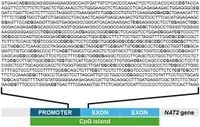A significant study has shed light on the potential of N-acetyltransferase 2 (NAT2) promoter methylation as a specific biomarker for anti-tuberculosis drug-induced liver injury (ATDILI) in patients undergoing tuberculosis treatment. Conducted by researchers at Mahidol University, the analysis involved 102 tuberculosis patients, of whom 49 experienced ATDILI while 53 did not, along with a group of 100 healthy controls.
Tuberculosis, a serious infectious disease caused by the bacterium Mycobacterium tuberculosis, is treated with a combination of drugs including rifampicin and isoniazid. However, this treatment is often complicated by significant side effects, most notably ATDILI, which can lead to severe health complications, including liver failure. In this context, finding reliable biomarkers for early detection of ATDILI is crucial.
In the study, the researchers quantified the NAT2 promoter methylation in blood leukocytes using a method known as quantitative real-time methylation-specific polymerase chain reaction (qMSP). Their findings revealed that tuberculosis patients had a significantly reduced NAT2 demethylation index compared to healthy controls, suggesting hypermethylation of NAT2 in these patients.
Importantly, patients suffering from ATDILI exhibited an even lower NAT2 demethylation index compared to those without liver injury. This decrease was independently associated with an increased susceptibility to ATDILI, presenting an odds ratio of 4.62, underscoring the clinical relevance of the study.
The researchers also noted that measuring the NAT2 demethylation index within the first week of treatment was negatively correlated with serum aminotransferase levels taken between 8 to 60 days after treatment initiation. This indicates that a lower NAT2 demethylation index could reflect the progression of ATDILI, aligning with the principal aim of identifying effective biomarkers for early intervention.
Through receiver operating characteristic (ROC) curve analysis, the NAT2 demethylation index demonstrated not only sensitivity but also specificity in distinguishing between ATDILI and non-ATDILI cases when measured shortly after treatment onset. The study successfully established that NAT2 demethylation index provided a more effective diagnostic tool compared to traditional liver function tests, such as alanine aminotransferase (ALT) and aspartate aminotransferase (AST).
In a compelling discovery, Kaplan–Meier analysis confirmed the association between a lower demethylation index and a higher incidence of ATDILI among tuberculosis patients. "Kaplan–Meier analysis unveiled a notable association between lower NAT2 demethylation index and a higher incidence of ATDILI in tuberculosis patients," wrote the authors of the article.
This study, with its comprehensive design and robust findings, presents a promising avenue for enhancing the identification of ATDILI in clinical settings. The integration of NAT2 methylation analysis into routine clinical practice may significantly improve the management and outcomes of tuberculosis treatments, allowing for timely interventions that reduce the risk of severe liver injury.
Moving forward, further research is needed to validate these findings across larger and more diverse populations to fully establish NAT2 demethylation index as a reliable epigenetic biomarker for ATDILI. This pioneering work lays the groundwork for future developments in the realm of tuberculosis management and sheds light on the intricate relationship between genetic factors and drug-induced liver injury.




